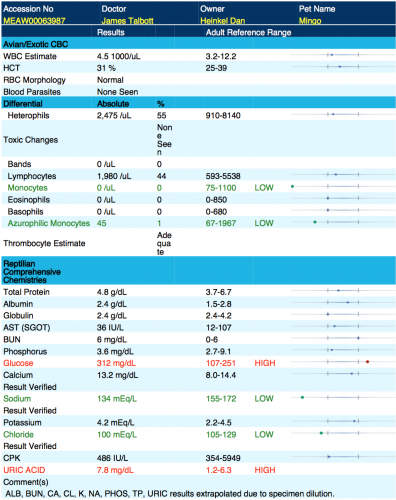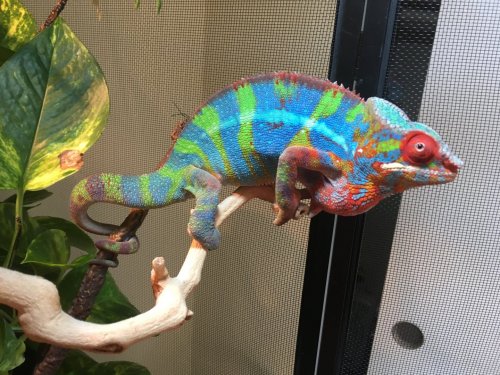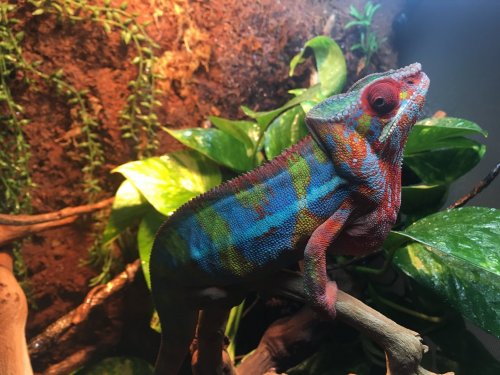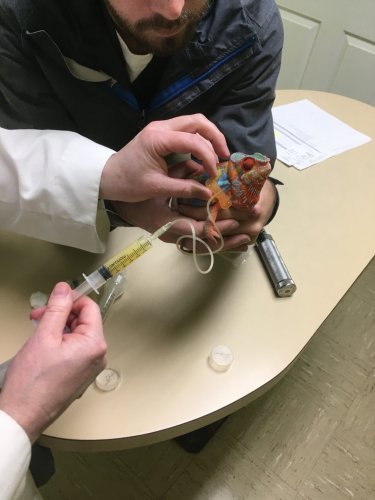DanoHeinkel
Member
◦ Your Chameleon - Male Ambilobe Panther, 9 month old. 6 inches N/V; 125 grams. Still growing. I bought Mingo 6 months ago from Kammurflage Kreations. I’ve had a stellar experience with them! They have been incredibly helpful!
◦ Handling - About once a week.
◦ Feeding - 6 Crickets and 1-2 Dubia Roaches daily--6 days a week. Gut loading using Repashy Bug Burger, Oranges, Melon, Zucchini, Grapefruit, Carrots, Apples and Bananas. I always have Bug Burger, one veggie and one fruit in the cricket enclosure at a time. (In the last few weeks I have stopped using carrots due to their high vitamin A content.)
◦ Supplements - Repashy CalciumPlus. Initially, I dusted at every feeding for the first 3 months. When the Edema formed, I stopped supplementing entirely for 6 weeks to see if I was over-supplementing (per the breeder’s advice). Now using a Low-D formula calcium powder.
◦ Watering - 1 nozzle Mist King system set to shower 10 minute at 8:30; 3 minutes and 10:30, 12:30, 2:30 and 4:30.
◦ Fecal Description - Stool is firm with white urate. Had a smear and float done: negative for bacterial infection and parasites. It has been smellier than usual for the last week and a half.
◦ History - About 4 months ago, Mingo’s urates were slightly yellow for about a week. He’s had previous health issues that I know of.
Cage Info:
◦ Cage Type - 18x18x36 all screen enclosure. Pictures below.
◦ Lighting - Up until 2 months ago, this was my lighting setup: 50 watt zoo-med basking bulb; 12” zoo-med t5 HO 5.0 UVB bulb. in April, I changed to a 75 watt basking bulb, and swapped UVB bulb to a 26watt zoo-med 5.0 CFL bulb. Lighting is on a 12 hour timer (7am-7pm).
◦ Temperature - Cage floor sits about 75, with the basking spot at 94 (the basking spot was 85 before the recent bulb change). Lowest overnight temp is 70. Measured using dial thermometers.
◦ Humidity - Humidity ranges from 30% to 55% after mistings. Measured using a dial hydrometer.
◦ Plants - 1 live Golden Pothos and 1 Croton Nervia at the bottom of his enclosure. He doesn’t have much contact (if any at all) with this plant.
◦ Placement - Mingo’s enclosure is located in a spare bedroom that doesn’t receive much foot traffic. The air vent is across the room, about 10’ away. The top of the enclosure is 6 feet from the ground.
◦ Location - Nashville, TN.
Current Problem - Gular Edema is the issue that I (and 3 vets) have been trying to diagnose for months now. The swelling especially seems to flare up after feeding and when he is introduced to stressors. The Edema HAS reduced over the last 2 weeks, though his tongue has worsened.
Recently, his tongue has started to weaken over the course of a month. Initially, he was missing high on his feeders; It gradually progressed to shooting his tongue only about an 2 inches out of his mouth. Now, he takes at least 15 minutes in between catching prey from his cup to reset his tongue and swallow his feeder. This is my biggest concern. It looks to me that his tongue is sitting against his airway after swallowing which causes him open mouth gape occasionally after feeding.
Also, his feces have been smellier than usual with a bubble or two present. In addition, small crystals have formed around his nostrils. Salt? Uric acid?
I’ve seen 3 different vets on multiple occasions. The first 2 had little experience with chameleons. The third was a referral after vet #2 needed help with diagnosis. I've been sticking with vet #3 who drew some fluid from his swelling and determined that it is a transudate fluid.
The 3 vets have prescribed (in this order): .1 MLs of Furosemide (to reduce swelling) .15 MLs of Baytril by mouth for 7 days, Meloxicam, (to see if the swelling was inflammation due to injury), 1 Baytril injection, and Pedialite. All of these meds were prescribed to see if anything would change. No change was seen using any prescription so far. He hasn't been on any of these meds for the last 2 months.
That brings us to this week. Dr #3 did a blood panel on Mingo. Unfortunately, he didn't have a blood panel standard for a panther chameleon, so he's not sure what to focus on. He's contacting colleagues to find one. In the meantime, any help from vets on this thread would be amazing! Do the symptoms and blood panel seem to be speaking to you in any way? Hypovitaminosis A? Kidney failure?
I recently started giving him 5 MLs of a vitamin B complex mixed with water daily for the last 3 days. That seemed to help his tongue slightly! Planning to continue this. Please ask clarifying question if needed! Thank you guys.
PS: Isn't he absolutely gorgeous?! Just had to throw that in there...
◦ Handling - About once a week.
◦ Feeding - 6 Crickets and 1-2 Dubia Roaches daily--6 days a week. Gut loading using Repashy Bug Burger, Oranges, Melon, Zucchini, Grapefruit, Carrots, Apples and Bananas. I always have Bug Burger, one veggie and one fruit in the cricket enclosure at a time. (In the last few weeks I have stopped using carrots due to their high vitamin A content.)
◦ Supplements - Repashy CalciumPlus. Initially, I dusted at every feeding for the first 3 months. When the Edema formed, I stopped supplementing entirely for 6 weeks to see if I was over-supplementing (per the breeder’s advice). Now using a Low-D formula calcium powder.
◦ Watering - 1 nozzle Mist King system set to shower 10 minute at 8:30; 3 minutes and 10:30, 12:30, 2:30 and 4:30.
◦ Fecal Description - Stool is firm with white urate. Had a smear and float done: negative for bacterial infection and parasites. It has been smellier than usual for the last week and a half.
◦ History - About 4 months ago, Mingo’s urates were slightly yellow for about a week. He’s had previous health issues that I know of.
Cage Info:
◦ Cage Type - 18x18x36 all screen enclosure. Pictures below.
◦ Lighting - Up until 2 months ago, this was my lighting setup: 50 watt zoo-med basking bulb; 12” zoo-med t5 HO 5.0 UVB bulb. in April, I changed to a 75 watt basking bulb, and swapped UVB bulb to a 26watt zoo-med 5.0 CFL bulb. Lighting is on a 12 hour timer (7am-7pm).
◦ Temperature - Cage floor sits about 75, with the basking spot at 94 (the basking spot was 85 before the recent bulb change). Lowest overnight temp is 70. Measured using dial thermometers.
◦ Humidity - Humidity ranges from 30% to 55% after mistings. Measured using a dial hydrometer.
◦ Plants - 1 live Golden Pothos and 1 Croton Nervia at the bottom of his enclosure. He doesn’t have much contact (if any at all) with this plant.
◦ Placement - Mingo’s enclosure is located in a spare bedroom that doesn’t receive much foot traffic. The air vent is across the room, about 10’ away. The top of the enclosure is 6 feet from the ground.
◦ Location - Nashville, TN.
Current Problem - Gular Edema is the issue that I (and 3 vets) have been trying to diagnose for months now. The swelling especially seems to flare up after feeding and when he is introduced to stressors. The Edema HAS reduced over the last 2 weeks, though his tongue has worsened.
Recently, his tongue has started to weaken over the course of a month. Initially, he was missing high on his feeders; It gradually progressed to shooting his tongue only about an 2 inches out of his mouth. Now, he takes at least 15 minutes in between catching prey from his cup to reset his tongue and swallow his feeder. This is my biggest concern. It looks to me that his tongue is sitting against his airway after swallowing which causes him open mouth gape occasionally after feeding.
Also, his feces have been smellier than usual with a bubble or two present. In addition, small crystals have formed around his nostrils. Salt? Uric acid?
I’ve seen 3 different vets on multiple occasions. The first 2 had little experience with chameleons. The third was a referral after vet #2 needed help with diagnosis. I've been sticking with vet #3 who drew some fluid from his swelling and determined that it is a transudate fluid.
The 3 vets have prescribed (in this order): .1 MLs of Furosemide (to reduce swelling) .15 MLs of Baytril by mouth for 7 days, Meloxicam, (to see if the swelling was inflammation due to injury), 1 Baytril injection, and Pedialite. All of these meds were prescribed to see if anything would change. No change was seen using any prescription so far. He hasn't been on any of these meds for the last 2 months.
That brings us to this week. Dr #3 did a blood panel on Mingo. Unfortunately, he didn't have a blood panel standard for a panther chameleon, so he's not sure what to focus on. He's contacting colleagues to find one. In the meantime, any help from vets on this thread would be amazing! Do the symptoms and blood panel seem to be speaking to you in any way? Hypovitaminosis A? Kidney failure?
I recently started giving him 5 MLs of a vitamin B complex mixed with water daily for the last 3 days. That seemed to help his tongue slightly! Planning to continue this. Please ask clarifying question if needed! Thank you guys.
PS: Isn't he absolutely gorgeous?! Just had to throw that in there...











